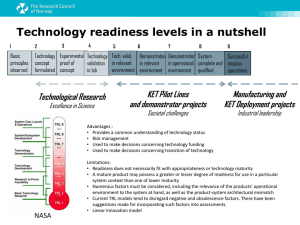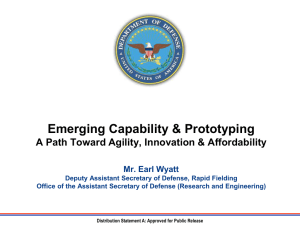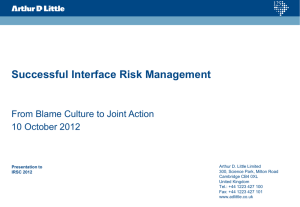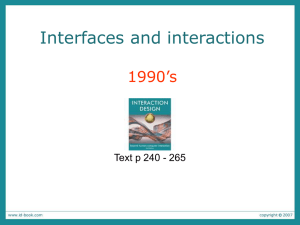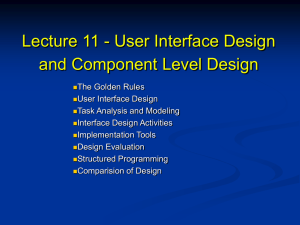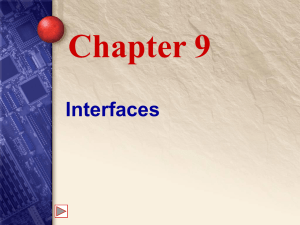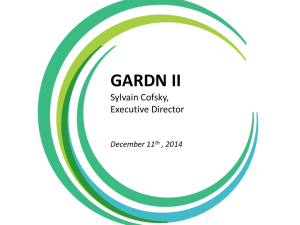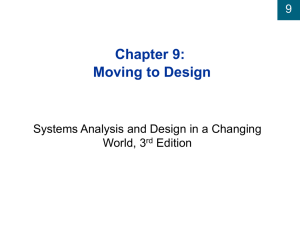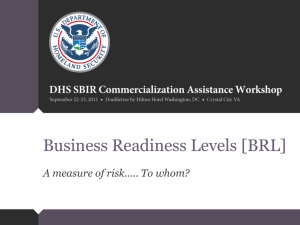PSM WW 2012 SDPM Projectl
advertisement
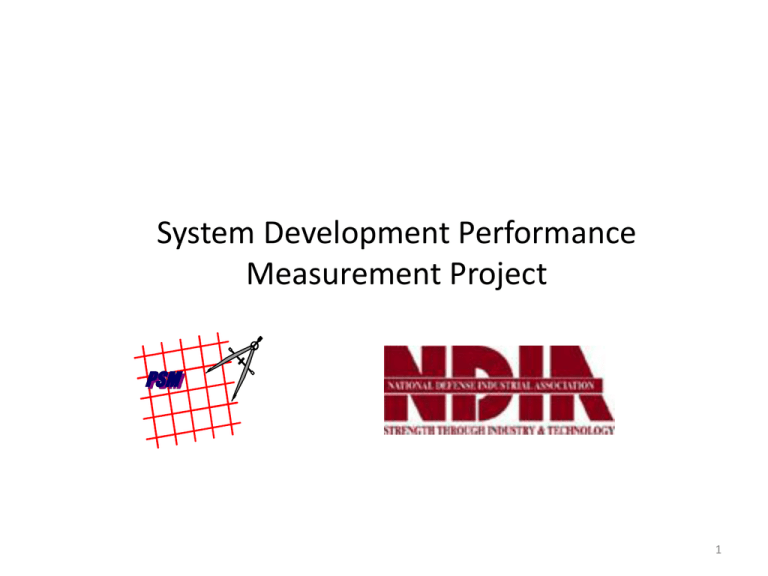
System Development Performance Measurement Project PSM 1 A Top Systems Engineering Issue Technical decision makers do not have the right information & insight at the right time to support informed & proactive decision making or may not act on all the technical information available to ensure effective & efficient program planning, management & execution. [NDIA Top Systems Engineering (SE) Issues (2010)] In September 2010, the NDIA Systems Engineering Effectiveness Committee chartered a working group to identify a small set of key leading indicators that would help address this issue. 2 PSM System Development Performance Measurement Project Identify potential high value – measures, – indicators, and – methods for managing programs, particularly in support of – making better technical decisions and – providing better insight into technical risk at key program milestones during – Technology Development and – Engineering and Manufacturing Development for both the acquirer and supplier Phase 1 Report is at www.ndia.org. Link to the Systems Engineering Division, and their page for Studies and Publications. First item at this page. Report is also available at www.psmsc.com under Products. 3 PSM Phase 1 Recommended Leading Indicators Information Need Specific Leading Indicator Requirements Requirements Stability Requirements Stakeholder Needs Met Interfaces Interface Trends Staffing and Skills Staffing and Skills Trends Risk Management Risk Burndown Technical Performance TPM Trend (specific TPM) Technical Performance TPM Summary (all TPMs) Technical Maturity Technology Readiness Level Manufacturability Manufacturing Readiness Level 4 Requirements & Interfaces Requirements Stability PDR CDR 1700 1600 1500 1400 1300 1200 1100 1000 Percent Change SRR Jan- Mar- May- Jul- Sep- Nov- Jan- Mar- May- Jul- Sep- Nov03 03 03 03 03 03 04 04 04 04 04 04 Number of Requirements System Requirements Stakeholder Needs Met Technical Measures (MOEs/KPPs) Satisfied and Validation Activities Completed Percent Adds Percent Deletes 20 Target Total Requirm ents 18 Percent Modifications 40 18 18 18 18 18 18 18 18 18 18 35 15 15 15 15 15 15 16 30 MOEs / KPPs 12 12 12 12 25 12 10 20 External Interface Completion8 160 15 6 10 140 4 Total Number of External Interfaces 2 120 Completed 5 Total Number of External Interfaces Planned To Be Completed 60 40 Lower Threshold for Interface Completion 20 Upper Threshold for Interface Completion Jul-11 Aug-11 Jun-11 Apr-11 May-11 Mar-11 Jan-11 Feb-11 Dec-10 Oct-10 Nov-10 Sep-10 Jul-10 Aug-10 Jun-10 Apr-10 May-10 Feb-10 Mar-10 Jan-10 0 Total Number of External Interfaces Planned To Be Resolved Jul-11 Aug-11 Jun-11 Apr-11 May-11 Mar-11 Jan-11 Feb-11 Oct-10 Dec-10 80 0 Nov-10 Total Number of External interfaces To Be Resolved Sep-10 Aug-10 Jul-10 Jun-10 Apr-10 May-10 Mar-10 Jan-10 100 Feb-10 Total Number of External Interfaces 0 Not Yet Defined Validation Activities 14 MOEs Not Satisfied MOEs Partially Satisfied MOEs Fully Satisfied Validation Activities (Plan) Validation Activities (Actual) Staffing & Risk 60 SE Staffing 50 40 SE Staff 30 (FTEs) 20 10 0 Jul-10 Aug-10 Sep-10 Oct-10 Nov-10 Dec-10 SE Staf f ing - Actual 35 Jan-11 Feb-11 Mar-11 Upper Threshold Apr-11 May-11 Jun-11 Jul-11 Aug-11 Sep-11 Oct-11 Jun-11 Jul-11 Aug-11 Sep-11 Oct-11 Lower Threshold SE Staff Experience 30 25 SE Staff (Average Experience) 20 15 10 5 0 Jul-10 Aug-10 Sep-10 Oct-10 Nov-10 Dec-10 SE Staf f ing - Actual Jan-11 Feb-11 Upper Threshold Mar-11 Apr-11 May-11 Lower Threshold Technical Performance, Technical Maturity and Manufacturability Name Respon sible Position /IPT KPP or KSA Perfor mance Spec. PDR Status Actual MS B Status Actual CDR Status Actual MS C Status Planned FRP Status Planned Aerodynamic Drag (count) Thermal Utilization (kW) SE IPT <222 225 223 220 187 187 SE IPT <60 56 59 55 51 50 Electrical Power Usage (kW) Operating Weight (lb) SE IPT <201 150 185 123 123 123 SE IPT <99,000 97,001 101,001 97,001 85,540 85,650 Range (nm) SE IPT >1,000 1,111 1,101 1,111 1,122 1,130 Average Flyaway Unit Cost (number) SE IPT System Milestone <1.5 MRL 1.35 1.32Comments / Risk Action Plan *Note: Margin is 10% / Technical Review ITR ASR MS A SRR TRL 1.3 (Plan) TRL 2 TRL 3 TRL 4 TRL 5 TRL 1.58 SFR TRL 6 TRL 5 MRL 6 MRL 5 PDR / MS B TRL 6 TRL 6 MRL 6 MRL 6 CDR TRR SVR (FCA PRR) MS C FRP Decision Review TRL 7 TRL 7 TRL 7 TRL 8 TRL 9 (Actual) TRL 3 TRL 3 TRL 3 TRL 4 MRL 1.37 (Plan) MRL 2 MRL 3 MRL 4 MRL 5 MRL 7 MRL 8 MRL 8 MRL 9 MRL 10 (Actual) MRL 2 MRL 3 MRL 3 MRL 3 Analysis model based on ABC study Lab validation of ASIC mfg concept Study funding delayed 30 d. TRA completed. Mechanical packaging ICD validation issues. Supplier facility contention elevated. Prototyped XYZ subsystem w/ test bed I/F. Investigating low yield on lot 6 wafer fab. Dwgs on plan. Tin whisker fab issue ok. Producibility plan approved. Evaluating alternative µW feeds (risk #23). Example: Interface Stability Indicator Name Information Need(s) Question(s) Addressed Measurable Concept Leading Insight Provided Base Measures Derived Measures Interface Trends Interfaces Evaluate the growth, change, and correctness of external interfaces. Is the definition of external interfaces correct and complete? SE activities associated with correctness and completeness (i.e., approved) and validation of the definition and design of system external non-hardware interfaces. Evaluates the stability and adequacy of the interfaces between the system under development to other systems to which it provide or receives information to understand the risks to other activities towards providing required capability, ontime and within budget. Total Number of External Interfaces at the end of the reporting period (e.g., monthly) Total Number of External Interfaces Completed(determined by the application of explicit criteria) at the end of the reporting period Total Number of External Interfaces Not Yet Defined at the end of the reporting period Total Number of External interfaces To Be Resolved (interface defined but not completed; that is, have outstanding issues) at the end of the reporting period Total Number of External Interfaces planned to be completed by the end of the reporting period Total Number of External Interfaces planned to be resolved by the end of the reporting period Total Number of External Interfaces = Total Number of External Interfaces Completed + Total Number of External Interfaces Not Yet Defined + Total Number of External Interfaces To Be Resolved Example: Interface Stability Decision Criteria Interpretation and Usage The plans should be based on results expected to be achieved at major milestones. For example, all external interfaces are defined at PDR and all issues are resolved by CDR. For unresolved interfaces use a tolerance band around the plan as Plan Value +/- <some percent> of Plan Value, e.g., Plan Value +/- 10%. The percent used should be based on historical experience on successful programs. For interface definitions use a tolerance band around the plan as Plan Value +/- <some percent> of (Total Interfaces Not Yet Defined) For both unresolved interfaces and interface definitions, investigate if a tolerance is exceeded for the latest reporting period or if the trend over the last several reporting periods is consistently trending toward a tolerance limit. If values are below the lower tolerance limit or trending towards the lower tolerance limit, then identify the dependent program activities impacted, define and evaluate the risks, and take actions to control the exposure. If values are above the upper tolerance limit or trending towards the upper tolerance limit, then the correctness and completeness of the definitions should be reviewed to ensure the quality requirements have been met. Additional A similar approach can be used for internal non-hardware interfaces., for example Considerations combat systems “Complete”, as used here, means the interface has been defined and determined to be complete through analysis or modeling and simulation, but has not been tested Showing major milestones on the chart is helpful for interpretation. Example: Interface Stability Example "Time Now" is May-11, which is when all interfaces were planned to be completed. However, fifteen remain, with the chart indicating these will be completed within three months. Corrective action was attempted mid-stream but was not sufficient to recover schedule. Since completions were trending toward and crossing the lower threshold much earlier, the basic lesson learned is to take action aggressively when anomalous behavior is first detected. PSM Phase 2 Directions • Determine leading indicators that address the other important information needs identified by the working group – – – – – Architecture Affordability Testability Requirements Verification and Validation Defects and Errors • Validate initial indicator set via survey and/or pilots • Recommendations on Benchmarking • Harmonize contractor reporting and government requirements Contact Pete McLoone, peter.j.mcloone@lmco.com, for more information. 11 2012 Strategy Leverage Other Industry Teams PSM Affordability Measurement Project Affordability Indicator(s) PSM Architecture Design Measurement Project SDPM Core Team Report Architecture Indicator(s) Testability Indicator(s) NDIA Test/ Eval WG ?? Reqmts V&V Indicator(s) NDIA Ver/Val WG ?? Defects and Errors Indicator(s) ?

